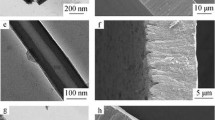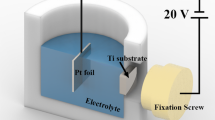Abstract
Ti alloys are widely applied in implanted biomedical devices due to their unique mechanical and biological performances. A strategy employed to improve bone integration on orthopedic and dental implants is to grow a self-organized TiO2 nanotube layer on the surface of titanium alloy implants. This paper describes the formation of self-organized TiO2 nanotubes on Ti–35Nb–2Zr and Ti–35Nb–4Zr alloys by the anodization process, as well as the effects of Zr content on TiO2 phase stability. The morphological and chemical characteristics of the nanotubes were analyzed by scanning electron microscopy, X-ray diffraction, and X-ray photoelectron microscopy. In addition, a comparison was made of the electrochemical stabilities of TiO2 nanotube-coated surfaces and surfaces without nanotubes, which revealed higher corrosion resistance for the nanotube-modified surface. The electrochemical impedance spectroscopy results were fitted with two-time constant equivalent circuit representing the barrier layer (nanotube bottom) and the porous layer (nanotube wall). The addition of Zr suppressed ω-phase formation, preserving the alloy’s low elastic modulus (64 GPa). This Zr addition also delayed the anatase-to-rutile transformation and slightly increased the nanotubes’ length to 1.14 µm. These features make the Ti–35Nb–4Zr alloy a very good candidate for use in the biomedical field, especially for applications that require low elastic modulus with enhanced corrosion resistance.
Graphic abstract








Similar content being viewed by others
References
Sul YT (2003) The significance of the surface properties of oxidized titanium to the bone response: special emphasis on potential biochemical bonding of oxidized titanium implant. Biomaterials 24:3893–3907
Geetha M, Singh AK, Asokamani R, Gogi AK (2009) Ti based biomaterials, the ultimate choice for orthopaedic implants—a review. Prog Mater Sci 54(3):397–425
Lee CM, Ju CP, Chern Lin JH (2002) Structure–property relationship of cast Ti–Nb alloys. J Oral Rehabil 29:314–322
Geetha M, Singh AK, Gogia AK, Asokamani R (2004) Effect of thermomechanical processing on evolution of various phases in Ti–Nb–Zr alloys. J Alloys Compd 384:131–144
Niinomi M (1998) Mechanical properties of biomedical titanium alloys. Mater Sci Eng, A 243:231–236
Hao YL, Li SJ, Sun SY, Yang R (2006) Effect of Zr and Sn on Young’s modulus and superelasticity of Ti–Nb-based alloys. Mater Sci Eng, A 441:112–118
Wang B, Liu Z, Gao Y, Zhang S, Wang X (2007) Microstructural evolution during aging of Ti-10 V-2Fe-3Al titanium alloy. J Univ Sci Technol Beijing Miner Metall Mater 14:335–340
Ghicov A, Schmuki P (2009) Self-ordering electrochemistry: a review on growth and functionality of TiO2 nanotubes and other self-aligned MOx structures. Chem Commun 20:2791–2808
Tan AW, Pingguan-Murphy B, Ahmad R, Akbar SA (2012) Review of titania nanotubes: fabrication and cellular response. Ceram Int 38:4421–4435
Bauer S, Schmuki P, von der Mark K, Park J (2013) Engineering biocompatible implant surfaces: Part I: materials and surfaces. Prog Mater Sci 58:261–326
Gongadze E, Kabaso D, Bauer S, Slivnik T, Schmuki P, van Rienen U, Iglič A (2011) Adhesion of osteoblasts to a nanorough titanium implant surface. Int J Nanomed 6:1801
Bagno A, Di Bello C (2004) Surface treatments and roughness properties of Ti-based biomaterials. J Mater Sci 15:935–949
Liu X, Chu PK, Ding C (2004) Surface modification of titanium, titanium alloys, and related materials for biomedical applications. Mater Sci Eng: R: Rep 47:49–121
Kim WG, Choe HC, Ko YM, Brantley WA (2009) Nanotube morphology changes for Ti–Zr alloys as Zr content increases. Thin Solid Films 517:5033–5037
ASTM International, E112–96 (2004) Standard test methods for determining average grain size. ASTM Int 1996:1–26. https://doi.org/10.1520/E0112-96R04
Málek J, Hnilica F, Veselý J, Smola B, Kolařík K, Fojt J, Vlach M, Kodetová V (2016) The effect of Zr on the microstructure and properties of Ti-35Nb-XZr alloy. Mater Sci Eng, A 675:1–10
Abdel-Hady M, Fuwa H, Hinoshita K, Kimura H, Shinzato Y, Morinaga M (2007) Phase stability change with Zr content in β-type Ti–Nb alloys. Scr Mater 57(11):1000–1003
Moraes PE, Contieri RJ, Lopes ES, Robin A, Caram R (2014) Effects of Sn addition on the microstructure, mechanical properties and corrosion behavior of Ti–Nb–Sn alloys. Mater Charact 96:273–281
Choe HC, Kim JU, Jeong YH (2012) Nanotube growth analysis in the interface between oxide film and titanium alloy substrate using STEM and FE-SEM. Surf Interface Anal 44(11–12):1473–1478
Banerjee S, Tewari R, Dey GK (2006) Omega phase transformation—morphologies and mechanisms. Int J Mater Res 97:963–977
Li Q, Niinomi M, Nakai M, Cui Z, Zhu S, Yang X (2012) Effect of Zr on super-elasticity and mechanical properties of Ti–24 at% Nb–(0, 2, 4) at% Zr alloy subjected to aging treatment. Mater Sci Eng, A 536:197–206
Hickman BS (1969) The formation of omega phase in titanium and zirconium alloys: a review. J Mater Sci 4:554–563
Jeong YH, Choe HC, Brantley WA (2012) Electrochemical and surface behavior of hydyroxyapatite/Ti film on nanotubular Ti–35Nb–xZr alloys. Appl Surf Sci 258:2129–2136
Ghicov A, Aldabergenova S, Tsuchyia H, Schmuki P (2006) TiO2–Nb2O5 nanotubes with electrochemically tunable morphologies. Angew Chem Int Ed 45:6993–6996
Kim KH, Ramaswamy N (2009) Electrochemical surface modification of titanium in dentistry. Dent Mater J 28:20–36
Jang SH, Choe HC, Ko YM, Brantley WA (2009) Electrochemical characteristics of nanotubes formed on Ti–Nb alloys. Thin Solid Films 517:5038–5043
Macák JM, Tsuchiya H, Schmuki P (2005) High-aspect-ratio TiO2 nanotubes by anodization of titanium. Angew Chem Int Ed 44:2100–2102
Albu SP, Ghicov A, Aldabergenova S, Drechsel P, LeClere D, Thompson GE, Schmuki P, Macak JM (2008) Formation of double-walled TiO2 nanotubes and robust anatase membranes. Adv Mater 20:4135–4139
González-Elipe AR, Munuera G, Espinos JP, Sanz JM (1989) Compositional changes induced by 3.5 keV Ar+ ion bombardment in Ni-Ti oxide systems: a comparative study. Surf Sci 220:368–380
Wagner CD, Zatko DA, Raymond RH (1980) Use of the oxygen KLL Auger lines in identification of surface chemical states by electron spectroscopy for chemical analysis. Anal Chem 52:1445–1451
Yuan B, Wang Y, Bian H, Shen T, Wu Y, Chen Z (2013) Nitrogen doped TiO2 nanotube arrays with high photoelectrochemical activity for photocatalytic applications. Appl Surf Sci 280:523–529
Munirathinam B, Neelakantan L (2016) Role of crystallinity on the nanomechanical and electrochemical properties of TiO2 nanotubes. J Electroanal Chem 770:73–83
Kokubo T, Kim HM, Kawashita M (2003) Novel bioactive materials with different mechanical properties. Biomaterials 24(13):2161–2175
Uchida M, Kim HM, Kokubo T, Fujibayashi S, Nakamura T (2003) Structural dependence of apatite formation on titania gels in a simulated body fluid. J Biomed Mater Res, Part A 64(1):164–170
Ghosh M, Öner D, Duca RC, Cokic SM, Seys S, Kerkhofs S, Van Landuyt K, Hoet P, Godderis L (2017) Cyto-genotoxic and DNA methylation changes induced by different crystal phases of TiO2-np in bronchial epithelial (16-HBE) cells. Mutat Res Fundam Mol Mech f Mutagenes 796:1–12
Bai Y, Park IS, Park HH, Lee MH, Bae TS, Duncan W, Swain M (2011) The effect of annealing temperatures on surface properties, hydroxyapatite growth and cell behaviors of TiO2 nanotubes. Surf Interface Anal 43(6):998–1005
Cremasco A, Osorio WR, Freire CMA, Garcia A, Caram R (2008) Electrochemical corrosion behavior of a Ti–35Nb alloy for medical prostheses. Electrochim Acta 53:4867–4874
Devaraj A, Nag S, Srinivasan R, Williams REA, Banerjee S, Banerjee R, Fraser HL (2012) Experimental evidence of concurrent compositional and structural instabilities leading to ω precipitation in titanium–molybdenum alloys. Acta Mater 60(2):596–609
Jeong YH, Choe HC, Brantley WA (2012) Electrochemical and surface behavior of hydyroxyapatite/Ti film on nanotubular Ti–35Nb–xZr alloys. Appl Surf Sci 258(6):2129–2136
Pan J, Thierry D, Leygraf C (1996) Electrochemical impedance spectroscopy study of the passive oxide film on titanium for implant application. Electrochim Acta 41(7–8):1143–1153
Gonzalez JEG, Mirza-Rosca JC (1999) Study of the corrosion behavior of titanium and some of its alloys for biomedical and dental implant applications. J Electroanal Chem 471(2):109–115
Silva TM, Rito JE, Simoes AMP, Ferreira MGS, da Cunha Belo M, Watkins KG (1998) Electrochemical characterisation of oxide films formed on Ti-6Al-4 V alloy implanted with Ir for bioengineering applications. Electrochim Acta 43(1–2):203–211
Tomashov ND, Chernova GP, Ruscol YS, Ayuyan GA (1974) The passivation of alloys on titanium bases. Electrochim Acta 19(4):159–172
Hefny MM, Mazhar AA, El-Basiouny MS (1982) Dissolution behaviour of titanium oxide in H2SO4 and NaOH from impedance and potential measurements. Br Corros J 17(1):38–41
El-Basiouny MS, Mazhar AA (1982) Electrochemical behavior of passive layers on titanium. Corrosion 38(5):237–240
Lavos-Valereto IC, Wolynec S, Ramires I, Guastaldi AC, Costa I (2004) Electrochemical impedance spectroscopy characterization of passive film formed on implant Ti–6Al–7Nb alloy in Hank’s solution. J Mater Sci 15(1):55–59
Cordeiro JM, Beline T, Ribeiro ALR, Rangel EC, Barão VAR (2017) Development of binary and ternary titanium alloys for dental implants. Dent Mater 33:1244–1257
Li Q, Li J, Ma G, Liu X, Pan D (2016) Influence of ω phase precipitation on mechanical performance and corrosion resistance of Ti–Nb–Zr alloy. Mater Des 111(5):421–428
Saji VS, Choe HC, Brantley WA (2009) An electrochemical study on self-ordered nanoporous and nanotubular oxide on Ti–35Nb–5Ta–7Zr alloy for biomedical applications. Acta Biomater 5:2303–2310
Bai Y, Li SJ, Hao YL, Yang R (2012) Electrochemical corrosion behavior of Ti-24Nb-4Zr-8Sn alloy in a simulated physiological environment. Appl Surf Sci 258:4035–4040
Hitzig J, Jüttner K, Lorenz WJ, Paatsch W (1986) AC-impedance measurements on corroded porous aluminum oxide films. J Electrochem Soc 133(5):887–892
Mansfeld F, Kendig MW (1988) Evaluation of anodized aluminum surfaces with electrochemical impedance spectroscopy. J Electrochem Soc 135(4):828–833
Karthega M, Raman V, Rajendran N (2007) Influence of potential on the electrochemical behaviour of β titanium alloys in Hank’s solution. Acta Biomater 3(6):1019–1023
Głuzek J, Masalski J, Furman P, Nitsch K (1997) Structural and electrochemical examinations of PACVD TiO2 films in Ringer solution. Biomaterials 18(11):789–794
Acknowledgements
The authors are grateful to the LNNano (National Nanotechnology Laboratory) at the CNPEM (National Center for Research on Energy and Materials) for allowing access to its SEM facilities. The authors also acknowledge the financial supports of the Brazilian research funding agencies FAPESP (São Paulo Research Foundation) under Grants 2014/00159-2 and 2016/24693-3; and CNPq (National Council for Scientific and Technological Development) under Grant 405054/2016-5, and also thank the Brazilian niobium mining and processing company, CBMM, for supplying the Nb used in this study.
Author information
Authors and Affiliations
Corresponding author
Additional information
Publisher's Note
Springer Nature remains neutral with regard to jurisdictional claims in published maps and institutional affiliations.
Rights and permissions
About this article
Cite this article
Fatichi, A.Z., Mello, M.G., Caram, R. et al. Self-organized TiO2 nanotube layer on Ti–Nb–Zr alloys: growth, characterization, and effect on corrosion behavior. J Appl Electrochem 49, 1079–1089 (2019). https://doi.org/10.1007/s10800-019-01345-8
Received:
Accepted:
Published:
Issue Date:
DOI: https://doi.org/10.1007/s10800-019-01345-8




